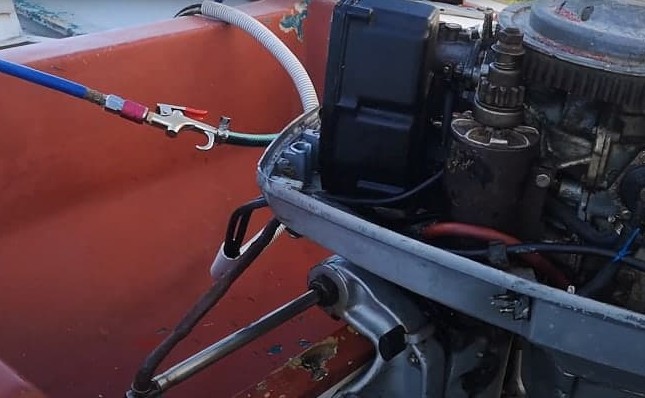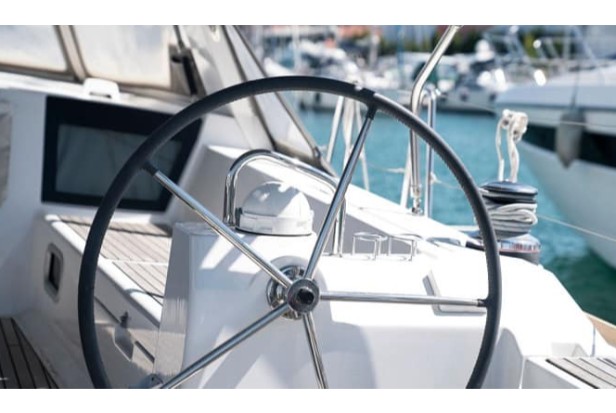We’ll go over some typical causes of boat steering cable stiffness in this article, as well as some preventative measures you can take, in addition to giving you a step-by-step tutorial on how to unfreeze a boat steering cable.
This problem affects a lot of boaters over time, and it’s difficult to notice until the cable seizes and locks up entirely. By releasing the tube from the arm with a vise grip and loosening the nuts, a steering cable can be defrosted. To remove the cable, turn the steering wheel. Before coming back, lubricate and clean.
Prepare the Following Tools
If you want to try the heating method, you will need a
- Welding torch
- Grease gun
- A companion to steer the wheel
Should you decide to take the more common route of disassembling and cleaning the tilt tube and steering cable, prepare the following:
- Carburetor cleaner
- Hammer (if necessary to get the tube out)
- Vise grip or wrench
- Welding torch
- Clean rag
- Wire brush
- Razorblade (for dislodging stubborn grease)
The replacement of the steering cable or tilt tube is your final option.
Since all of these techniques have produced fruitful results for me, I have no preference for any one of them. Depending on what the problem calls for, I only have to choose one.
What You Will Need to Unfreeze a Boat Steering Cable
Before I discuss the steps, here are the materials you need to prepare:
- Wrench
- Vise grip
- Sandpaper
- Penetrating oil
- Warm water
- Mild soap
Applying Heat to the Tilt Tube
This approach is not always effective. But it doesn’t hurt to give this technique a shot, especially if you want to fix a stiff boat steering cable caused by hardened grease inside the tube. Many of the boats I’ve owned have had their steering cables defrosted by doing this.
Do keep in mind that it is rarely a long-term fix. I’ve had a lot of boats get stuck, and a lot of the time it’s because of rust. It would be best to replace the steering cable and tube if that were the case.
Whatever the case, this is a simple, one-step process that needs a helping hand. This is how I go about it:
One Person Applies Heat and Grease to the Tube While Another Slowly Turns the Steering Wheel
With the aid of a welding torch, I heat the tilt tube. To melt any grease that may have hardened and been the source of the resistance. While another person rotates the helm left and right, one person simultaneously applies heat and grease. If you notice that the resistance is waning as you proceed, everything is going according to plan.
Once more, only if grease is the main cause of your issue should you anticipate success. If not, you will be forced to remove the cable in order to figure out why it keeps getting stuck.

How to Unfreeze a Boat Steering Cable by Cleaning the Steering Cable and Tilt Tube
Consider using this approach if you want to deal with stuck steering cables in a more thorough manner. Of course, this assumes that the issue only involves a small amount of rust and solidified grease covering the steering cable or tilt tube.
If there is too much rust buildup, you’ll probably have to skip this step and go straight to the preventative technique in the next section. However, it won’t harm to check the overall condition of your steering cable, so if you want to, it’s worthwhile.
Step 1. Take the Steering Cable Out
In every boat, this step is very different. This step has occasionally taken hours for me, but it has also occasionally only lasted a short while. My experience indicates that a lot of rust or grease is to blame if you’re having trouble removing the steering rod. In actuality, I’m going to err on the side of the latter.
The steering cable and tilt tube will likely only need to be cleaned if that is the case. If you’re trying to take the cable, I’m willing to bet that you’ll encounter nuts that are challenging to turn. I occasionally use kerosene to loosen the nuts.
To completely remove the steering cable from the tilt tube, it might be necessary to repeatedly hammer the other end of the cable. Another option is to use a welding torch to heat the tube, which will cause the grease to soften and make it easier for the rod to slide through.
Once more, much of this will depend on how your boat is set up, and this step could take hours due to rust and bad grease buildup. In order to save time when replacing the rod, I typically slid a new rod in while using the old one as a guide. If, however, that is not your goal, you will simply need to persevere until the steering cable is removed.
Step 2. Diagnose the Problem
You can identify the source of the resistance by cutting the steering cable.
You can attempt to turn the helm once more. The resistance is most likely coming from the tilt tube if the cable can enter and exit freely and the motor’s pivot tube can rotate freely.
The steering cable has a severe rust issue that can be challenging to fix if the helm isn’t turning freely. If this is the case, you might have to replace it. The same is true for difficult-to-turn pivot tubes.
However, if most of it is simply solidified grease, as is the case with most stainless steel steering cables, you can try cleaning it.
Step 3. Clean the Steering Cable’s Rod
Spray a fine mist of carburetor cleaner on the rod, paying special attention to the areas where the grease has hardened. With a clean rag, wipe the areas that were sprayed, taking care to completely or nearly completely dissolve the grease mass.
You can use a more powerful brush, such as a wire brush, to remove grease that is proving to be too difficult to remove. Because it won’t scratch the stainless steel’s surface, it’s the ideal option. I’ve even successfully used a razor blade a couple of times. Try to remove all of the grease.
Step 4. Clean the Tilt Tube
To soften the grease, add more carburetor cleaner to the tilt tube. Rolling a small piece of rag just slightly smaller in diameter than the tubes is one clever way I handle this.
I saturate the rag in cleaner, insert it into the tube, and then use another rod or stick that fits to push the rag to the other end. You can use a hammer if inserting the rag is too difficult. Make sure to repeat this step three to four times for a thorough clean.
Step 5. Regrease the Rod Then Put It Back into the Tube
First, lightly coat the entire length of the rod with lithium grease. According to me, it prevents accruals better than the majority of marine-grade oils.
Once you’ve finished, you can reinstall the cable. This can sometimes be accomplished with a single, fluid pushing motion. Other times, you’ll need to select the best working angle. Hammering it in is not something I advise. Wait until the cable is completely tucked inside the tube.
After completing these steps, the helm should turn more smoothly.
The Best Preventative Approach
I believe that preventing the issue from arising in the first place is the most practical course of action. By taking care of issues like corrosion buildup and grease buildup, which are frequently encountered. The optimal setup I did for one my vessels with a 40HP Merc is this:
- To replace the severely corroded tilt tube, I put in a new stainless steel one.
- I then added a collar with a zerk fitting to the end to make lubricating the whole assembly simpler.
Even with frequent use, up until this point I haven’t had to perform boat steering cable repair on it. As long as it’s possible, I try to do this on almost every boat I own because it saves me the trouble of having to remove the steering cable.
Should you need to replace the steering cable, this video is a good point of reference:
Conclusion
If you know how to do it, unfreezing a steering cable for a boat is simple. The tube can be released and put back together with just a wrench and a vise grip. Apply a penetrant spray, such as Liquid Wrench Gunk Penetrating Oil, to the steering cable to clean it.
FAQs
Why Boat Steering Hard to Turn One Way?
Steering Responds Well in Only One Direction – The relief valve for the hydraulic helm pump is stuck. Turn the wheel to hard full lock and apply pressure until the relief valve opens to fix it. Repetition of this procedure in the opposite direction.
What Causes Stiff Steering Cable on Boat?
Make sure there is enough grease on the motor before doing anything else if your boat’s steering feels unusually stiff. To keep the parts moving and working the way they are supposed to, grease is required. It might be challenging to turn the steering wheel without this lubrication.
Why is My Boat Steering Not Working?
Unresponsive Steering – If the steering feels soft or mushy, it’s usually a sign of air in the hydraulic system or the hydraulic fluid needing a change. By bleeding the system, the old hydraulic fluid and any air will be removed.
Does WD-40 Work as Cable Lube?
WD-40 is not a proper lubrication for throttle cables.
How Do You Fix Stiff Power Steering?
If electric steering is stiff only in one direction the usual cause is that the steering system is out of calibration and the usually fix is recalibrating it with the scan tool. This one really is that easy.

